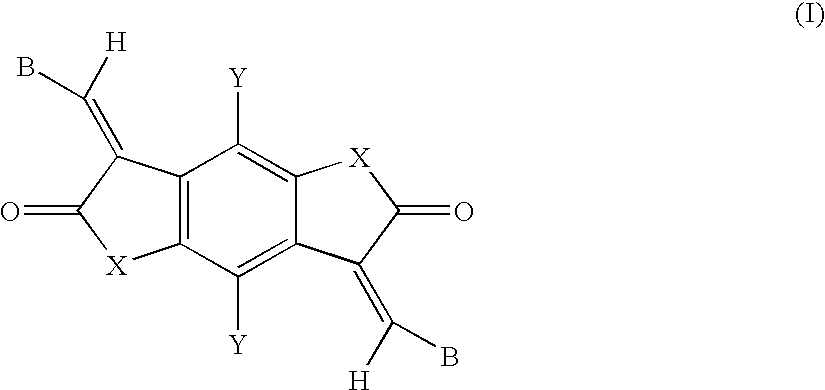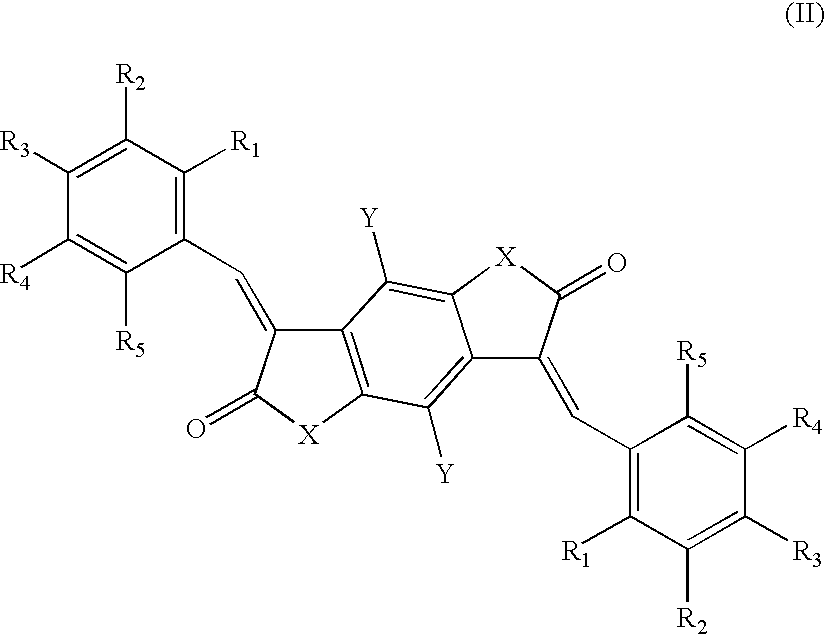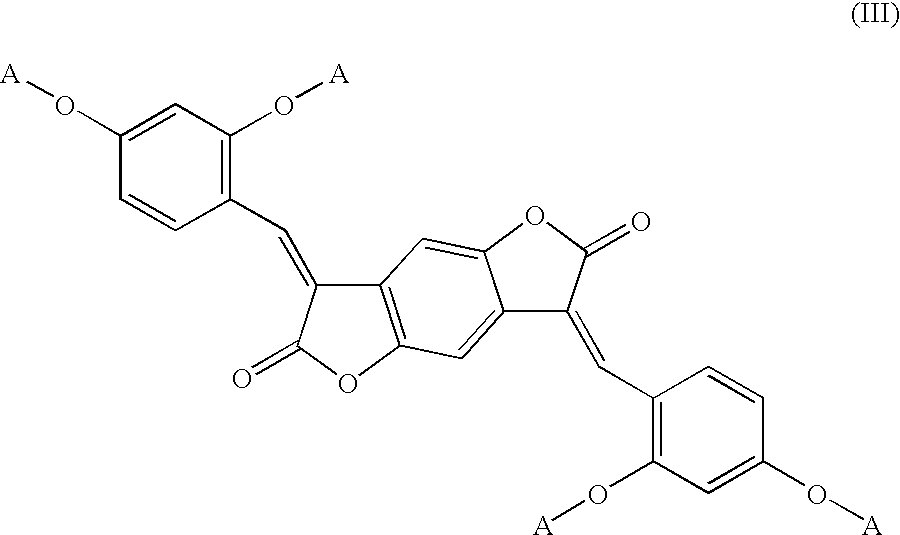Polymeric articles comprising novel bismethine benzodifuranone derivative colorants
a technology of bismethine benzodifuranone and derivatives, which is applied in the field of polymer articles comprising novel bismethine benzodifuranone derivative colorants, can solve the problems of colorants that exhibit certain problems, staining problems, and many of the previously disclosed compositions are not stable at the polyester processing temperatur
- Summary
- Abstract
- Description
- Claims
- Application Information
AI Technical Summary
Problems solved by technology
Method used
Image
Examples
example 1
[0038] To a 250 mL round bottom flask containing 33.0 g of alkoxylated (2EO 10PO 6EO) para-formyl aniline was added glycine (0.36 g), 2,5-dihydroxy-1,4-benzenediacetic acid-di-gamma-lactone [produced in accordance with the method taught within Wood et al., Journal of the American Chemical Society, 66, 1541 (1944)] (2.98 g), and water (25 g). The ensuing reaction mixture was placed on a rotary evaporator and mixed for approximately 5 minutes. The reaction mixture was then heated to 90-95.degree. C. for 2.5 hours while a water aspirator vacuum was applied to the rotary evaporator. The ensuing red liquid was allowed to cool to ambient temperature overnight. Water (80 g) was then added to the product. The mixture was then stirred on the rotary evaporator and heated to 75-80.degree. C. The mixture was then poured into a separatory funnel and allowed to phase for 30 minutes during which time two layers formed. The bottom product layer was removed and mixed with an additional 80 g of water...
example 2
[0039] To a 250 mL round bottom flask containing 26.2 g of alkoxylated (10EO) aldehyde of 2,5-dimethoxyaniline was added glycine (0.35 g), 2,5-dihydroxy-1,4-benzenediacetic acid-di-gamma-lactone (4.03 g), and water (20 g). The ensuing reaction mixture was placed on a rotary evaporator and mixed for approximately 5 minutes. The reaction mixture was then heated to 90-95.degree. C. for 2.5 hours while a water aspirator vacuum was applied to the rotary evaporator. The ensuing blue liquid was allowed to cool to ambient temperature overnight. Water (20 g) was then added to the product. The reaction mixture was then heated to 90-95.degree. C. for 2 hours while a water aspirator vacuum was applied to the rotary evaporator to give a thick blue oil exhibiting a .lambda..sub.max absorbance (in methanol) of 581 nm.
example 3
[0040] To a 3-neck, 100 mL round bottom flask containing 30 g of alkoxylated (2EO 6PO 6EO) aldehyde of 2,5-dimethoxyaniline was added glycine (0.21 g), 2,5-dihydroxy-1,4-benzenediacetic acid-di-gamma-lactone (3.23 g), and water (10 g). The ensuing reaction mixture was heated to 80-85.degree. C. for 4 hours. The ensuing blue liquid was allowed to cool to ambient temperature and stir overnight. The mixture was then transferred to a 1-neck 250 mL round bottom flask and stripped on a rotoary evaporator for 2 hours at 90-95.degree. C. Water (90 g) was then added to the product. The solution was mixed and heated to 80.degree. C. before being poured into a separatory funnel. The solution was allowed to phase separate. The bottom product layer was drained and was again washed as above with 90 g of water. The ensuing product layer was stripped via rotary evaporator to give 26 g of a blue oil exhibiting a .lambda..sub.max absorbance (in methanol) of 577 nm.
PUM
| Property | Measurement | Unit |
|---|---|---|
| thickness | aaaaa | aaaaa |
| thickness | aaaaa | aaaaa |
| thickness | aaaaa | aaaaa |
Abstract
Description
Claims
Application Information
 Login to View More
Login to View More - R&D
- Intellectual Property
- Life Sciences
- Materials
- Tech Scout
- Unparalleled Data Quality
- Higher Quality Content
- 60% Fewer Hallucinations
Browse by: Latest US Patents, China's latest patents, Technical Efficacy Thesaurus, Application Domain, Technology Topic, Popular Technical Reports.
© 2025 PatSnap. All rights reserved.Legal|Privacy policy|Modern Slavery Act Transparency Statement|Sitemap|About US| Contact US: help@patsnap.com



